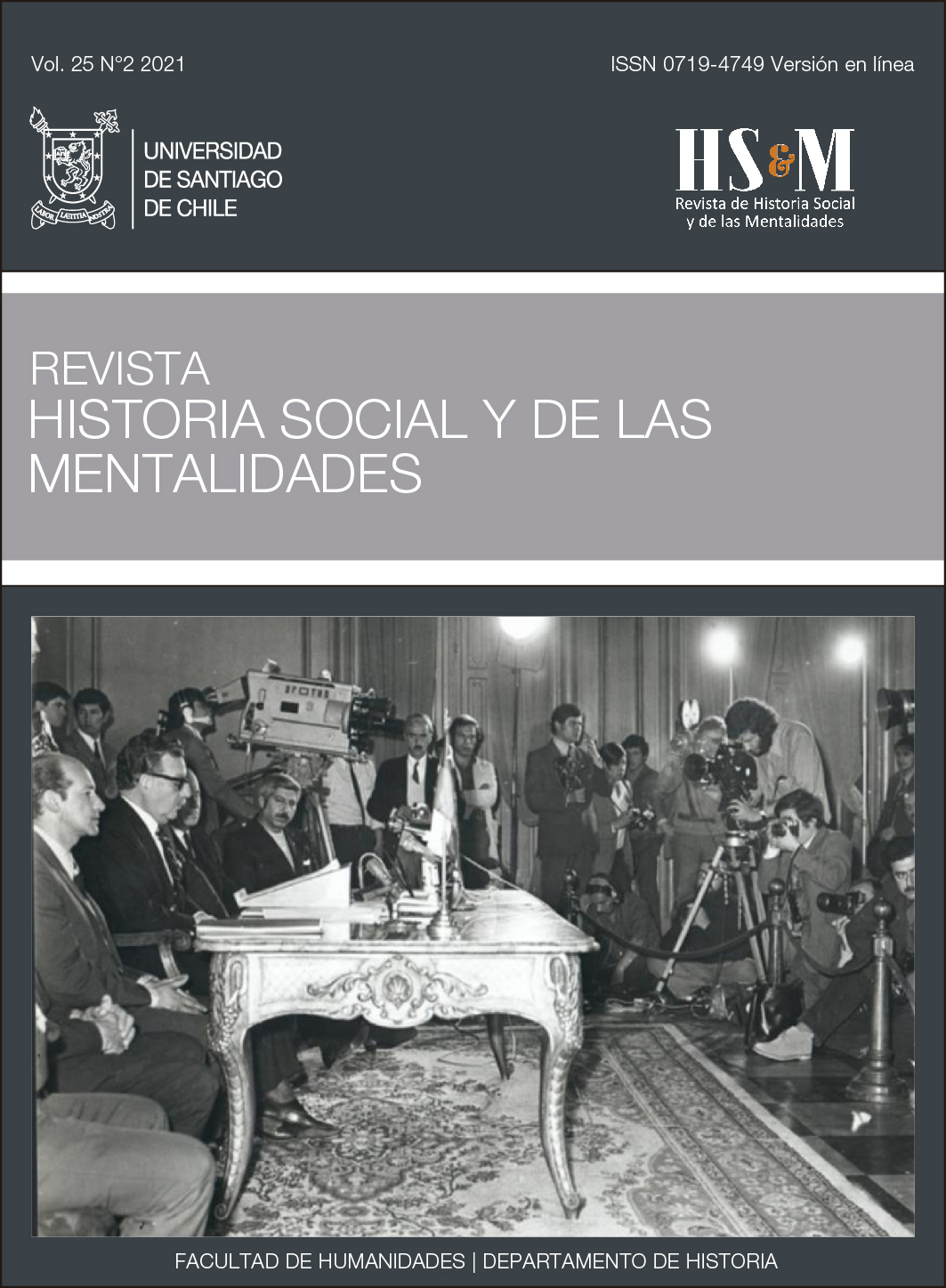ON THE NOTION OF THE MONSTROUS IN KANT’S CRITICAL PHILOSOPHY
DOI:
https://doi.org/10.35588/rhsm.v25i2.4696Keywords:
Victim, Perpetrator, Monster, KantAbstract
This article discusses the aesthetical category of the monstrous, which is usually used to represent perpetrators. We believe that the monstrous does not properly approach the object that is meant to qualify, insofar as –from a philosophical-political point of view– when we say of someone that it is a monster, we say that he, she, or they exceed our capacity of understanding. We will show this deficiency through an analysis of this problem in Immanuel Kant’s philosophy to demonstrate that to reduction of the perpetrator to the monstrous has a very limited political performance
Downloads
References
Aagaard-Mogensen, Lars. The Possibility of the Sublime: Aesthetic Exchanges. Cambridge Scholars Publishing, 2018.
Acosta, María del Rosario. “Tras cien años de olvido. Sobre la literatura y el arte como resistencia a las borraduras de la historia”. Escribir la violencia, editado por Ilit Ferber, Aïcha Messina y Andrea Potestà, Metales Pesados, 2019, pp. 57-78.
Arcangeli et al. “Awe and the Experience of the Sublime: A Complex Relationship”. Frontiers in Psychology, vol. 11, 2020, https://doi.org/10.3389/fpsyg.2020.01340.
Arendt, Hannah. The Origins of Totalitarianism. Harcourt, 1967.
—. Lectures on Kant’s political philosophy. University of Chicago Press, 1992.
—. Eichmann in Jerusalem: a report on the banality of evil, Penguin Books, 2006.
Basaure, Mauro. “La monstruosidad y Pinochet”. El Desconcierto, 24 de mayo del 2018, https://www.eldesconcierto.cl/opinion/2018/05/24/la-monstruosidad-y-pinochet.html
Battersby, Christine. The Sublime, Terror and Human Difference. Routledge, 2007.
Brady, Emily. The Sublime in Modern Philosophy: Aesthetics, Ethics, and Nature. Cambridge University Press, 2013.
Brinkmann, Sören. “La fascinación del terror: El nuevo Centro de Documentación en Núremberg”. Aula-Historia Social, vol. 10, 2002, pp. 81-91.
Clewis, Robert R. (ed.) The Sublime Reader. Bloomsbury, 2019.
Dikeç, Mustafa. “Politics is sublime”. Environment and Planning D: Society and Space, vol. 30, no. 2, Apr. 2012, pp. 262-279. https://doi.org/10.1068/d12610
Fulbrook, Mary. Reckonings: Legacies of Nazi Persecution. Oxford University Press, 2018.
Gadamer, Hans-Georg. Verdad y método. Tomo II, Ediciones Sígueme, 1998.
Garrido, Juan Manuel. El imperativo de la humanidad. Orjikh, 2012.
Geisenhanslüke, Achim. “Dummheit und Witz bei Kant”. Monströse Ordnungen: zur Typologie und Ästhetik des Anormalen, editado por Achim Geisenhanslüke & Georg Main, Transcript, 2009, pp. 617-653.
Geisenhanslüke, Achim, Georg Mein & Rasmus Overthun, R. “Einleitung”. Monströse Ordnungen: zur Typologie und Ästhetik des Anormalen, editado por Achim Geisenhanslüke & Georg Main, Transcript, 2009, pp. 9-18.
Hur, Young-Jin et al. “Facing the Sublime: Physiological Correlates of the Relationship between Fear and the Sublime”. Psychology of Aesthetics, Creativity, and the Arts, vol. 14, 2020, pp. 253-263, https://doi.org/10.1037/aca0000204.
Johnson, David. “The Postmodern Sublime. Presentation and Its Limits”. The Sublime from Antiquity to the Present, editado por Timothy M. Costelloe, Cambridge University Press, 2012, pp. 118-131.
Joignant, Alfredo. “El museo como provocación”. La Segunda, 15 de mayo de 2018, p. 13.
Kant, Immanuel. Crítica de la facultad de juzgar (KdU). Traducción de Pablo Oyarzún, Monte Ávila Latinoamericana, 1992.
—. Crítica de la razón práctica (KpV). Traducción de Dulce María Granja Castro de Probert, Colihue, 2013.
—. Crítica de la razón pura (KrV). Traducción de Mario Caimi, Colihue, 2014.
—. Observaciones acerca del sentimiento de lo bello y de lo sublime (Obs – Beobachtungen). Traducción de Luis Jiménez Moreno, Alianza Editorial, 2017.
—. La religión dentro de los límites de la mera razón. Traducción de Felipe Martínez Marzoa, Alianza, 1981.
Lowe, Paul. “Picturing the Perpetrator”. Picturing Atrocity. Photography in Crisis, editado por Batchen, G., Gidley, M., N. Miller y Prosser, Reaktion Books, 2012, pp.189-200.
Lyotard, Jean-François. L’Inhumain. Galilée, 1988.
Oyarzún, Pablo. “Introducción del traductor”. Crítica de la facultad de juzgar (KdU) de Immanuel Kant, Monte Ávila Latinoamericana, 1992, pp.7-18.
Paterson, Tony. “Hitler exhibition breaks Germany’s last taboo”. Independent, 14 de octubre del 2010.
Pseudo-Longino. De lo sublime. Traducción de Eduardo Molina C. y Pablo Oyarzún R., Metales Pesados, 2007.
Rancière, Jacques. Malaise dans l’esthétique. Galilée, 2004.
Rogozinski, Jacob. “The sublime monster”. The sublime and its Teleology, editado por Donald Loose, Brill, 2011, pp. 159-168.
—. “Al límite de lo Ungeheure. Sublime y el monstruoso en la Crítica de la facultad de juzgar”. Revista de Teoría del Arte, no. 8, 2003, pp. 121-151.
Schenk, Ralf. “ ‘Als Hitler den Krieg überlebte’: Wenn aus dem Rächer das neue Ungeheuer wird”. Berliner Zeitung, 5 de junio del 2020, https://www.berliner-zeitung.de/kultur-vergnuegen/film-tipp-als-hitler-den-krieg-ueberlebte-wenn-aus-dem-raecher-das-neue-ungeheuer-wird-li.85736.
Schinkle, Eugenie. “Boredom, Repetition, Inertia: Contemporary Photography and the Aesthetics of the Banal”. Mosaic: An Interdisciplinary Critical Journal, vol. 37, no. 4, 2004, pp. 165-184. https://www.jstor.org/stable/44030032
Thamer, Hans-Ulrich. “Hitler im Museum? Ein Erfahrungsbericht zur Ausstellung ‘Hitler und die Deutschen’”. Zeithistorische Forschungen/Studies in Contemporary History, vol. 8, no. 1, 2011, pp. 88-101. https://doi.org/10.14765/zzf.dok-1672
Downloads
Submitted
2020-11-19Published
Issue
Section
License
Copyright (c) 2021 Revista de Historia Social y de las Mentalidades

This work is licensed under a Creative Commons Attribution-NonCommercial-NoDerivatives 4.0 International License.













